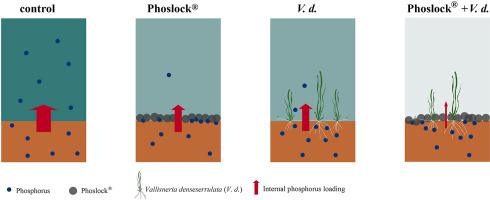Environmental Pollution ( IF 8.9 ) Pub Date : 2021-02-19 , DOI: 10.1016/j.envpol.2021.116720 Xiumei Zhang , Wei Zhen , Henning S. Jensen , Kasper Reitzel , Erik Jeppesen , Zhengwen Liu

|
Establishment of submerged macrophyte beds and application of chemical phosphorus inactivation are common lake restoration methods for reducing internal phosphorus loading. The two methods operate via different mechanisms and may potentially supplement each other, especially when internal phosphorous loading is continuously high. However, their combined effects have so far not been elucidated. Here, we investigated the combined impact of the submerged macrophyte Vallisneria denseserrulata and a lanthanum-modified bentonite (Phoslock®) on water quality in a 12-week mesocosm experiment. The combined treatment led to stronger improvement of water quality and a more pronounced reduction of porewater soluble reactive phosphorus than each of the two measures. In the combined treatment, total porewater soluble reactive phosphorus in the top 10 cm sediment layers decreased by 78% compared with the control group without Phoslock® and submerged macrophytes. Besides, in the upper 0–1 cm sediment layer, mobile phosphorus was transformed into recalcitrant forms (e.g. the proportion of HCl–P increased to 64%), while in the deeper layers, (hydr)oxides-bound phosphorus species increased 17–28%. Phoslock®, however, reduced the clonal growth of V. denseserrulata by 35% of biomass (dry weight) and 27% of plant density. Our study indicated that Phoslock® and submerged macrophytes may complement each other in the early stage of lake restoration following external nutrient loading reduction in eutrophic lakes, potentially accelerating the restoration process, especially in those lakes where the internal phosphorus loading is high.
中文翻译:

大型植物(Vallisneria densityserrulata)和镧改性的膨润土对浅水富营养化湖泊水质的综合影响:中观研究
建立水下大型植物床和化学磷灭活的应用是减少内部磷负荷的常见湖泊修复方法。这两种方法通过不同的机制运行,并且可能相互补充,特别是当内部磷负载持续很高时。但是,到目前为止,还没有阐明它们的综合作用。在这里,我们研究了淹没植物植物苦草(Vallisneria densityserrulata)的综合影响。在为期12周的中观试验中,使用镧改性的膨润土(Phoslock®)改善了水质。与这两种措施相比,联合处理导致水质得到更强的改善,并且孔隙水溶性可溶性磷的减少更为显着。在联合处理中,与没有Phoslock®和沉水植物的对照组相比,最上方10 cm沉积物层中总的水溶性水溶性活性磷降低了78%。此外,在0-1cm的上层沉积物中,可移动的磷转化为re难形式(例如,HCl-P的比例增加到64%),而在更深的层中,(氢)氧化物结合的磷种类增加了17- 28%。但是,Phoslock®降低了致密弧菌的克隆生长减少35%的生物质(干重)和27%的植物密度。我们的研究表明,Phoslock®和淹没的大型植物在富营养化湖泊中外部养分减少之后,在湖泊恢复的早期可能会互补,有可能加速恢复过程,特别是在内部磷负荷高的湖泊中。



























 京公网安备 11010802027423号
京公网安备 11010802027423号